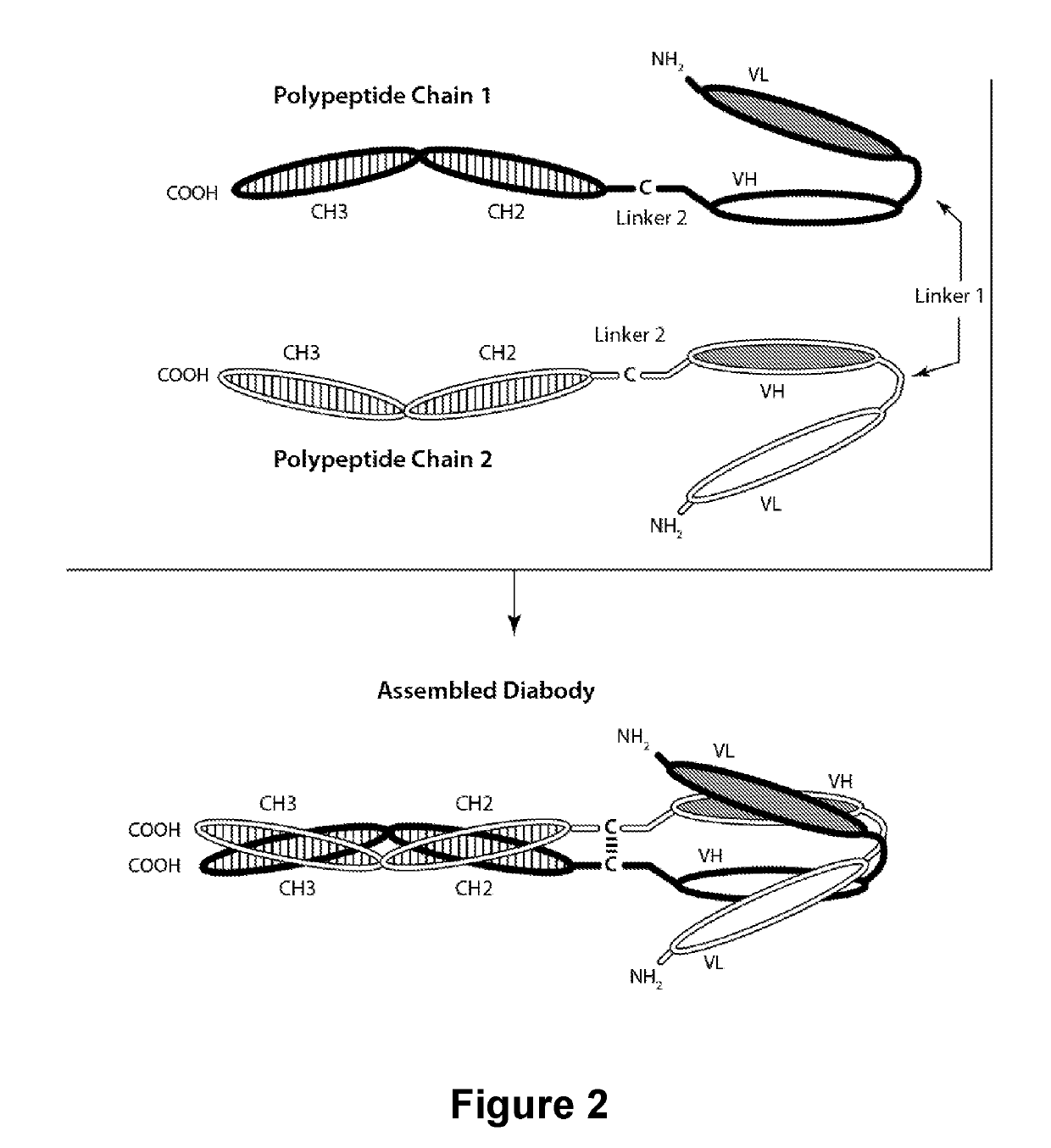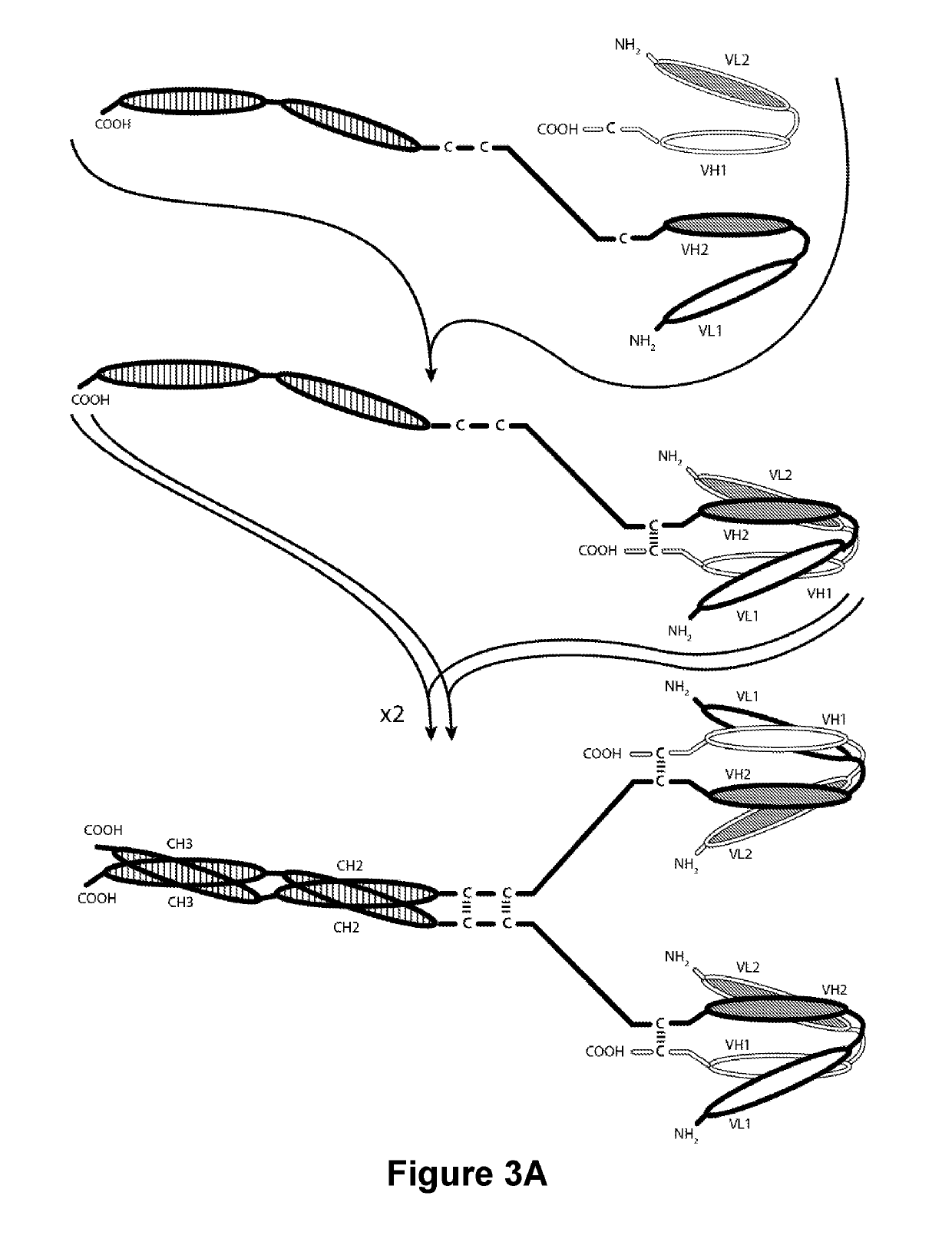PD-1-Binding Molecules and Methods of Use Thereof
a technology of binding molecules and pd-1, which is applied in the field of pd1 binding molecules, can solve the problems of hampered immune suppressive mechanisms in the tumor microenvironment, and achieve the effects of enhancing serum half-life and reducing affinity of variant fc regions
- Summary
- Abstract
- Description
- Claims
- Application Information
AI Technical Summary
Benefits of technology
Problems solved by technology
Method used
Image
Examples
example 1
Characterization of Anti-Human PD-1 Monoclonal Antibodies
[0656]Fifteen murine monoclonal antibodies were isolated as being capable specifically binding to both human and cynomolgus monkey PD-1, and accorded the designations “PD-1 mAb 1,”“PD-1 mAb 2,”“PD-1 mAb 3,”“PD-1 mAb 4,”“PD-1 mAb 5,”“PD-1 mAb 6,”“PD-1 mAb 7,”“PD-1 mAb 8,”“PD-1 mAb 9,”“PD-1 mAb 10,”“PD-1 mAb 11,”“PD-1 mAb 12,”“PD-1 mAb 13,”“PD-1 mAb 14,” and “PD-1 mAb 15.” The CDRs of these antibodies were found to differ and are provided above. Binding to the extracellular domain of human and cynomologus monkey PD-1 was evaluated as follows, flat bottom maxisorb 96-well plates were coated with soluble human or cynomolgus monkey PD-1 (the extracellular domain of human PD-1 fused to a His tag (shPD-1 His) or to a human Fc Region (shPD-1 hFc), or the extracellular domain of cynomolgus monkey PD-1 fused to a human Fc Region (scyno-PD1 Fc)) each at 0.5 or 1 μg / mL, the plates were washed and incubated with one of the isolated anti-PD...
example 2
Humanization and Further Characterization
[0663]The Variable Domains of the anti-PD-1 antibodies PD-1 mAb 1, PD-1 mAb 2, PD-1 mAb 7, PD-1 mAb 9, and PD-1 mAb 15 were humanized, where antigenic epitopes were identified the antibodies were further deimmunized to generate the final humanized Variable Domains. Humanization of PD-1 mAb 1, PD-1 mAb 2, and PD-1 mAb 15 yielded one humanized VH Domain and one humanized VL Domain for each antibody designated herein as “hPD-1 mAb 1 VH1,” and “hPD-1 mAb 1 VL1;”“hPD-1 mAb 2 VH1,” and “hPD-1 mAb 2 VL1;” and “hPD-1 mAb 15 VH1,” and “hPD-1 mAb 15 VL1.” Humanization of PD-1 mAb 7 yielded two humanized VH Domains, designated herein as “hPD-1 mAb 7 VH1,” and “hPD-1 mAb 7 VH2,” and three humanized VL Domains designated herein as “hPD-1 mAb 1 VL1,”“hPD-1 mAb 7 VL2,” and “hPD-1 mAb 7 VL3.” Humanization of PD-1 mAb 9 yielded two humanized VH Domains, designated herein as “hPD-1 mAb 9 VH1,” and “hPD-1 mAb 9 VH2,” and two humanized VL Domains designated here...
example 3
Blockade of the PD-1 / PD-L1 Checkpoint by Humanized Anti-Human PD-1 Antibodies
[0684]The ability of hPD-1 mAb 2 IgG1 (AA), hPD-1 mAb 7(1.1) IgG1 (AA), hPD-1 mAb 7(1.2) IgG1, (AA), hPD-1 mAb 7(1.2) IgG4 (P), hPD-1 mAb 9(1.1) IgG1 (AA), hPD-1 mAb 9(1.1) IgG4 (P), hPD-1 mAb 15 IgG1 (AA), and the reference anti-PD-1 antibodies PD-1 mAb A and PD-1 mAb B to antagonize the PD-1 / PD-L1 axis (i.e., block the PD-1 / PD-L1 interaction and prevent down-regulation of T-cell responses) was examined in a Jurkat-luc-NFAT / CHO-PD-L1 luciferase reporter assay. Briefly, CHO cells expressing PD-L1 (CHO / PD-L1) were plated at 40,000 / well in 100 μL of culture medium (RPMI+10% FBS+100 μg / mL Hygromycine B+100 μg / mL G418) and incubated overnight. The next day the media was removed and MNFAT-luc2 / PD-1 Jurkat cells (Promega) at 50,000 cells / well in 40 μL in assay buffer (RPMI+2% FBS), and the anti-PD-1 antibodies PD-1 mAb 1-15, or a reference anti-PD-1 antibodies (PD-1 mAb A and PD-1 mAb B) (0-25 μg / mL; eight 2.5 fo...
PUM
| Property | Measurement | Unit |
|---|---|---|
| affinity | aaaaa | aaaaa |
Abstract
Description
Claims
Application Information
 Login to View More
Login to View More - R&D
- Intellectual Property
- Life Sciences
- Materials
- Tech Scout
- Unparalleled Data Quality
- Higher Quality Content
- 60% Fewer Hallucinations
Browse by: Latest US Patents, China's latest patents, Technical Efficacy Thesaurus, Application Domain, Technology Topic, Popular Technical Reports.
© 2025 PatSnap. All rights reserved.Legal|Privacy policy|Modern Slavery Act Transparency Statement|Sitemap|About US| Contact US: help@patsnap.com



